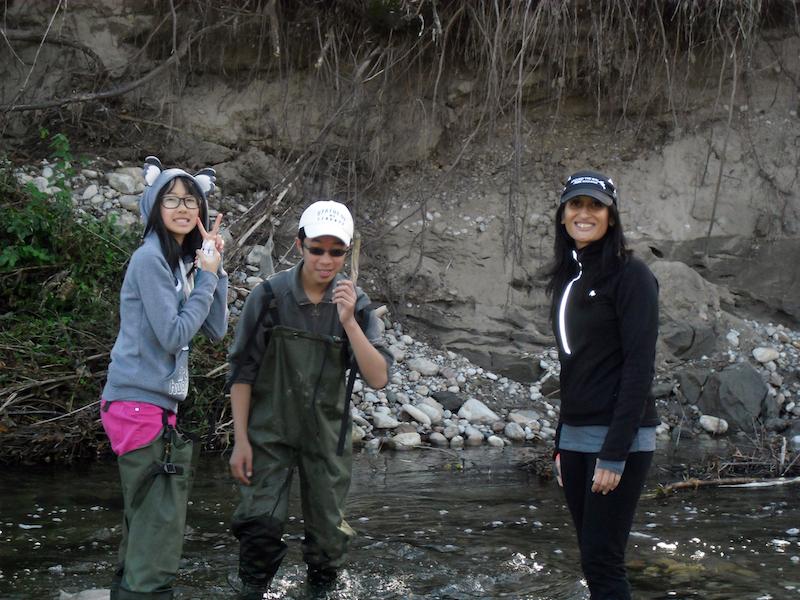
To Inquiry and Beyond! The Power of Place-Based Education
“A water what?” was the response I’d get whenever I introduced my grade 8 students to the concept of a watershed. “How can I get my students to engage when they don’t even understand the importance of our water systems?” I thought to myself. Needless to say I found it challenging to teach the Water Systems unit in Science and Technology. I knew that I needed to step it up! I had to find a way to use inquiry in the older grades and have my students connect with this important topic in a more meaningful way.
Starting the Environmental Inquiry Process
In September 2014, I decided that I was going to begin my Water Systems unit by using the inquiry process. I wanted to find out what my students already knew about this topic. Did any of them actually know about watersheds? Did they know that humans are a part of the water system and impact the other parts?
I began my inquiry by asking a general question: “What do you know about water on Earth?” My students came up with a lot of additional questions to which I added my own. Once we had our questions, we were able to focus on and plan around learning about watersheds, the impacts humans, technology and natural disasters have on them, and the effect of water systems on the climate.
Making Waves
“Great,” I thought, “we have the questions to get us started, but how will I get my students outside?” I considered a neighbourhood walk to Milliken Park to explore the water there, but how could I possibly do this on my own with just a limited supply of pH strips and make it meaningful? I decided that I would have to look into booking a stream study, but with whom and where? I hit a bump in the road.
Literally a few days later, my principal, William Parish, shared information with staff during a meeting. He mentioned an organization called EcoSpark and asked if any of us were interested in conducting a stream study through their Changing Currents Program. I was. This was exactly what I had been looking for.
A few days later, I received some material to cover before the trip. I taught my students about Benthic Macro-invertebrates (BMIs), what they looked like, and how we were going to collect and identify them. I won’t lie… my students were disgusted by the bugs they saw and heard about, but I assured them that it would be an amazing experience to learn about these bugs in nature.
In early October, my students, principal and I headed to Morningside Park in Toronto where we would assess and evaluate the condition of the stream in the Highland Creek watershed. There, we met with some incredible people from EcoSpark. They led us to a stream where we had a discussion and learned more about our local watershed. The next thing you know, a third of my students were in waders, shuffling the earth beneath their feet and using nets to collect BMIs.
They performed chemical and physical tests on water samples from the stream, testing for turbidity, temperature, acidity and dissolved oxygen levels. This got the conversation going and refocused our inquiry onto the plant and animal life supported by the watershed (especially after seeing a couple of salmon jump out of the water). Experiential and place-based learning gave my students a true understanding of watersheds.
I was pleasantly surprised that the biggest problem I experienced that day was getting my students out of the water and out of waders. Many even chose to spend their break just sitting in the stream or skipping stones with the principal. How incredible to see them appreciating nature!
After our stream study, more questions were raised and students investigated causes of pollution and solutions for maintaining clean water in our communities. That got them thinking more about local water issues. We discussed the importance of initiatives like the Yellow Fish Road Program, which raises awareness about pollutants entering local water bodies through storm drains. We talked as a class about how raising awareness can make a difference to the way we treat our water systems and what we could do to affect positive change.
Integrated Learning - It All Flows Together
Language Arts
One of the first things we did as a class once we returned to the school was complete an Adopt-a-BMI sheet. Students researched a BMI of their choice. They applied the concepts of voice and perspective writing to create diary entries from the point-of-view of a BMI. The entries were a fun way to assess my students’ understanding of the impact humans have on water systems and aquatic life.
“Today, there was yet another group of irresponsible children coming. They did exactly what the children from yesterday did. They destroyed our home. They captured us and put us in tiny compartments…it was horrible and I was really lonely.” – Jenny
“I am very sad humans dump their waste in our water. My family is always sick due to the pollution.” – Steven
The fact that there is less than one percent of accessible freshwater on our earth, and that we are contaminating it caused great concern among my students. They decided that they wanted to extend their experience at Highland Creek by raising greater awareness about the choices humans make (personal and industrial) in the use and consumption of freshwater sources.
Students’ desire to raise awareness gave me the opportunity to integrate Media and Oral Communication by having them create a Public Service Announcement (PSA) as a cumulative task. My class watched a number of pre-selected examples on YouTube and co-created learning goals and success criteria for an effective PSA. Breaking into small groups, they used the knowledge obtained from their research to create a PSA about a water issue of their choice (i.e., chemical contamination, overuse, inadequate supply of safe drinking water in a community, the vulnerability of water systems (i.e., fracking), the impact of the bottled water industry, etc.). I celebrated the students’ hard work by showing a few of their PSAs at school assemblies. Practical suggestions about reducing the amount of water we use/consume were shared with staff and students at that time.
Math
The children conducted a variety of tests using water samples. They had to record, graph and compare their findings and draw conclusions from them. Students recorded their data on the blackline masters provided by EcoSpark. There was even an online database that helped calculate and determine the health of a stream based on the BMIs collected during the stream study.
Visual Arts and Writing
My students visited Milliken Park on “Take Me Outside” day later in October. I planned a full day of outdoor activities that included using the pond as an inspiration to create watercolour paintings.
Stewardship
Water for the World Workshop
My grade 8 students participated in the Water for the World program in March 2015. This workshop is presented by Engineers Without Borders who lead discussions about local and global water issues, including questions about equity and access. As part of the workshop, students had the opportunity to build a water filtration system in small groups and further discuss how to improve both the condition of our water systems and access to water across the globe.
Aquatic Plants Program
My students wanted to do more. We learned about wetlands and how water-loving plants filter and purify water and decided to participate in the Aquatic Plants Program offered by the Toronto and Region Conservation Authority (TRCA). I asked five other teachers and their classes to join me. We received a kit at the beginning of April. This gave our students the chance to grow native aquatic plants. They then had the opportunity to go back to Morningside Park (where the journey began) in June to transplant what we grew. This outreach program taught them about storm water pollution, local wildlife and the importance of maintaining native plants.
It All Comes Together
Having gone through this amazing journey with my students, I decided to ask them again to explain what a watershed is.
“It’s like a container where all the water from streams, rivers and lakes goes into the same place,” a student responded. That’s a good answer.
Using the inquiry process and placebased learning has changed my teaching. Our learning was driven by my students’ curiosity, but the best part is that they decided to take on a stewardship role to help sustain our freshwater systems on their own!
Farah Wadia is a member of the Elementary Teachers of Toronto and one of the recipients of the 2015 RBC-Evergreen Watershed Champions Award.

